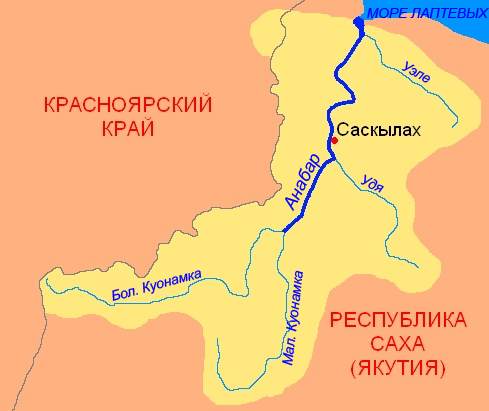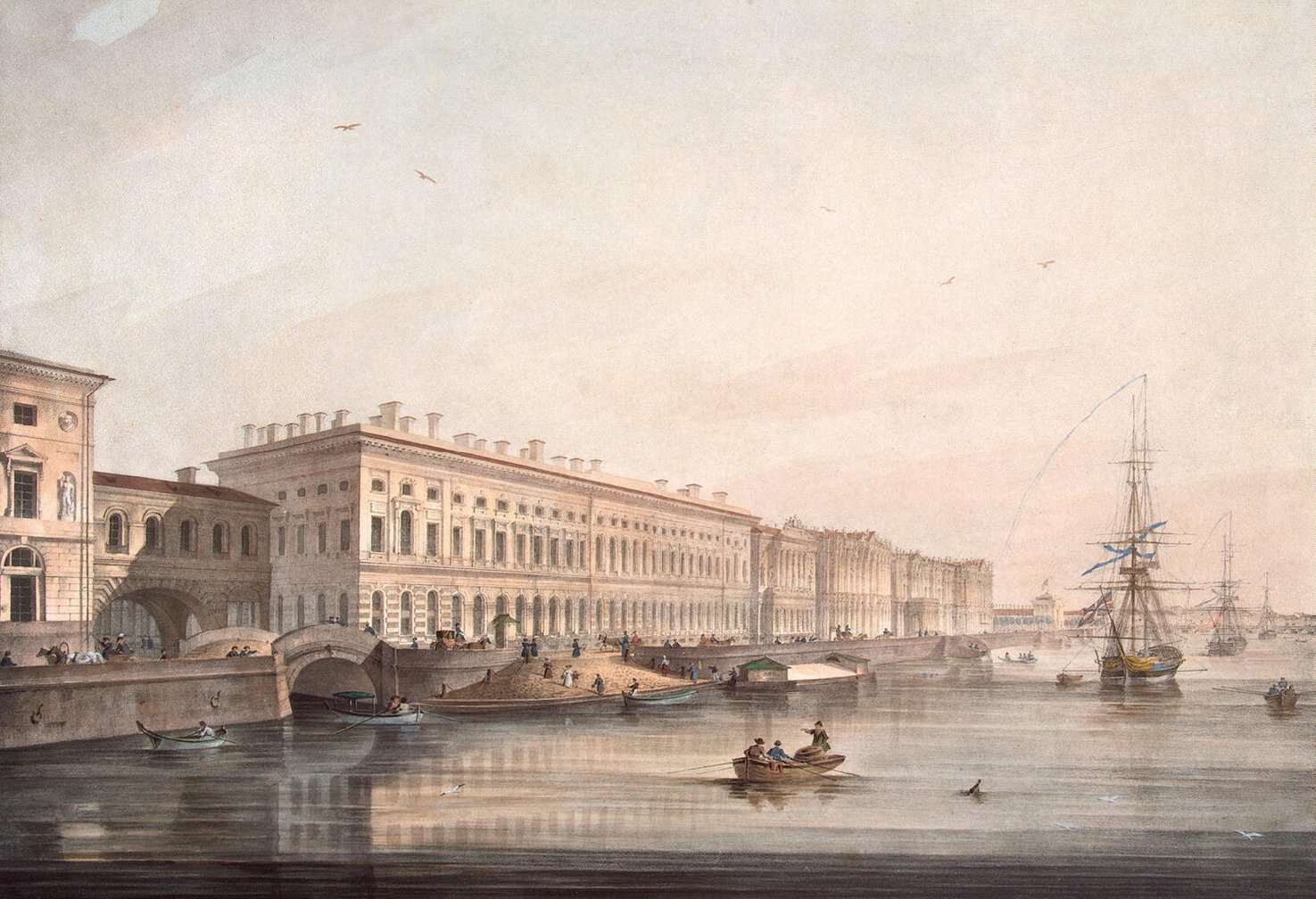|
Anabar (river)
The Anabar ( rus, Анабар, r=Anabar, in its upper course: Большая Куонамка ''Bolshaya Kuonamka''; sah, Анаабыр, translit=Anaabyr) is a river in Sakha, Russia. It is long ( counting the long Bolshaya Kuonamka ("Big Kuonamka") stretch of its upper course) and has a drainage basin of . Course The Anabar is formed at the confluence of the Malaya Kuonamka and Bolshaya Kuonamka at the edge of the North Siberian Lowland. The length of the Anabar proper is . The two rivers forming it have their sources in the northeastern part of the Anabar Plateau, part of the Central Siberian Plateau. There are many lakes in its basin. The Anabar basin is located between rivers Khatanga and Olenyok. The mouth of the river is in the Anabar Bay. Its mean annual discharge is , concentrated heavily in early summer when the ice that covers the river for most of the year thaws. The Uele river flows into the Laptev Sea close to the mouth of the Anabar, but it is not its ... [...More Info...] [...Related Items...] OR: [Wikipedia] [Google] [Baidu] |
Malaya Kuonamka
The Malaya Kuonamka (russian: Малая Куонамка; sah, Кыра Куонамка) is a river in Yakutia (Sakha Republic), Russia. It is a right tributary of the Anabar with a length of . Its drainage basin area is . The river flows north of the Arctic Circle, in the northern limits of the Central Siberian Plateau and the North Siberian Lowland. The area is very cold and desolate, devoid of settlements. The Kuonamka Formation is a Cambrian large igneous province in the northeastern Siberian platform. Course The Malaya Kuonamka "Little Kuonamka" is the second largest tributary of the Anabar. The river has its source in an elevated swamp at an altitude of in the eastern side of the Anabar Plateau. Together with the long Bolshaya Kuonamka "Big Kuonamka" to the west, it is one of the two rivers that form the Anabar at their confluence. In their last stretch both rivers flow roughly northwards. Finally they meet where the Anabar river proper begins, from its mo ... [...More Info...] [...Related Items...] OR: [Wikipedia] [Google] [Baidu] |
Rivers Of The Sakha Republic
A river is a natural flowing watercourse, usually freshwater, flowing towards an ocean, sea, lake or another river. In some cases, a river flows into the ground and becomes dry at the end of its course without reaching another body of water. Small rivers can be referred to using names such as creek, brook, rivulet, and rill. There are no official definitions for the generic term river as applied to geographic features, although in some countries or communities a stream is defined by its size. Many names for small rivers are specific to geographic location; examples are "run" in some parts of the United States, "burn" in Scotland and northeast England, and "beck" in northern England. Sometimes a river is defined as being larger than a creek, but not always: the language is vague. Rivers are part of the water cycle. Water generally collects in a river from precipitation through a drainage basin from surface runoff and other sources such as groundwater recharge, springs, a ... [...More Info...] [...Related Items...] OR: [Wikipedia] [Google] [Baidu] |
List Of Rivers Of Russia
Russia can be divided into a European Russia, European and an North Asia, Asian part. The dividing line is generally considered to be the Ural Mountains. The European part is drained into the Arctic Ocean, Baltic Sea, Black Sea, and Caspian Sea. The Asian part is drained into the Arctic Ocean and the Pacific Ocean. Notable rivers of Russia in Europe are Volga (which is the longest river in Europe), Pechora (river), Pechora, Don River, Russia, Don, Kama River, Kama, Oka River, Oka and the Northern Dvina, while several other rivers originate in Russia but flow into other countries, such as the Dnieper and the Western Dvina. In Asia, important rivers are the Ob River, Ob, the Irtysh River, Irtysh, the Yenisei River, Yenisei, the Angara River, Angara, the Lena River, Lena, the Amur River, Amur, the Yana River, Yana, the Indigirka River, Indigirka, and the Kolyma River, Kolyma. In the list below, the rivers are grouped by the seas or oceans into which they flow. Rivers that flow into o ... [...More Info...] [...Related Items...] OR: [Wikipedia] [Google] [Baidu] |
Soviet Union
The Soviet Union,. officially the Union of Soviet Socialist Republics. (USSR),. was a List of former transcontinental countries#Since 1700, transcontinental country that spanned much of Eurasia from 1922 to 1991. A flagship communist state, it was nominally a Federation, federal union of Republics of the Soviet Union, fifteen national republics; in practice, both Government of the Soviet Union, its government and Economy of the Soviet Union, its economy were highly Soviet-type economic planning, centralized until its final years. It was a one-party state governed by the Communist Party of the Soviet Union, with the city of Moscow serving as its capital as well as that of its largest and most populous republic: the Russian Soviet Federative Socialist Republic, Russian SFSR. Other major cities included Saint Petersburg, Leningrad (Russian SFSR), Kyiv, Kiev (Ukrainian Soviet Socialist Republic, Ukrainian SSR), Minsk (Byelorussian Soviet Socialist Republic, Byelorussian SSR), Tas ... [...More Info...] [...Related Items...] OR: [Wikipedia] [Google] [Baidu] |
Australia
Australia, officially the Commonwealth of Australia, is a sovereign ''Sovereign'' is a title which can be applied to the highest leader in various categories. The word is borrowed from Old French , which is ultimately derived from the Latin , meaning 'above'. The roles of a sovereign vary from monarch, ruler or ... country comprising the mainland of the Australian continent, the island of Tasmania, and numerous smaller islands. With an area of , Australia is the largest country by area in Oceania and the world's sixth-largest country. Australia is the oldest, flattest, and driest inhabited continent, with the least fertile soils. It is a megadiverse country, and its size gives it a wide variety of landscapes and climates, with deserts in the centre, tropical Forests of Australia, rainforests in the north-east, and List of mountains in Australia, mountain ranges in the south-east. The ancestors of Aboriginal Australians began arriving from south east Asia approx ... [...More Info...] [...Related Items...] OR: [Wikipedia] [Google] [Baidu] |
Africa
Africa is the world's second-largest and second-most populous continent, after Asia in both cases. At about 30.3 million km2 (11.7 million square miles) including adjacent islands, it covers 6% of Earth's total surface area and 20% of its land area.Sayre, April Pulley (1999), ''Africa'', Twenty-First Century Books. . With billion people as of , it accounts for about of the world's human population. Africa's population is the youngest amongst all the continents; the median age in 2012 was 19.7, when the worldwide median age was 30.4. Despite a wide range of natural resources, Africa is the least wealthy continent per capita and second-least wealthy by total wealth, behind Oceania. Scholars have attributed this to different factors including geography, climate, tribalism, Scramble for Africa, colonialism, the Cold War, neocolonialism, lack of democracy, and corruption. Despite this low concentration of wealth, recent economic expansion and the large and young ... [...More Info...] [...Related Items...] OR: [Wikipedia] [Google] [Baidu] |
Diamond
Diamond is a solid form of the element carbon with its atoms arranged in a crystal structure called diamond cubic. Another solid form of carbon known as graphite is the chemically stable form of carbon at room temperature and pressure, but diamond is metastable and converts to it at a negligible rate under those conditions. Diamond has the highest hardness and thermal conductivity of any natural material, properties that are used in major industrial applications such as cutting and polishing tools. They are also the reason that diamond anvil cells can subject materials to pressures found deep in the Earth. Because the arrangement of atoms in diamond is extremely rigid, few types of impurity can contaminate it (two exceptions are boron and nitrogen). Small numbers of defects or impurities (about one per million of lattice atoms) color diamond blue (boron), yellow (nitrogen), brown (defects), green (radiation exposure), purple, pink, orange, or red. Diamond also has a ... [...More Info...] [...Related Items...] OR: [Wikipedia] [Google] [Baidu] |
Evenks
The Evenks (also spelled Ewenki or Evenki based on their endonym )Autonym: (); russian: Эвенки (); (); formerly known as Tungus or Tunguz; mn, Хамниган () or Aiwenji () are a Tungusic people of North Asia. In Russia, the Evenks are recognised as one of the indigenous peoples of the Russian North, with a population of 38,396 ( 2010 census). In China, the Evenki form one of the 56 ethnic groups officially recognised by the People's Republic of China, with a population of 30,875 ( 2010 census). There are 537 Evenks in Mongolia (2015 census), called '' Khamnigan'' in the Mongolian language. Origin The Evenks or Ewenki are sometimes conjectured to be connected to the Shiwei people who inhabited the Greater Khingan Range in the 5th to 9th centuries, although the native land of the majority of Evenki people is in the vast regions of Siberia between Lake Baikal and the Amur River. The Ewenki language forms the northern branch of the Manchu-Tungusic language g ... [...More Info...] [...Related Items...] OR: [Wikipedia] [Google] [Baidu] |
Suolama
The Suolama (russian: Суолема, ''Suolema''; sah, Суолама) is a river in Krasnoyarsk Krai and Yakutia (Sakha Republic), Russia. It is a tributary of the Anabar (river), Anabar with a length of . Its drainage basin area is . The river flows north of the Arctic Circle, from the Taymyrsky Dolgano-Nenetsky District of Krasnoyarsk Krai eastwards into the northwestern limit of coastal Yakutia. It is an area of permafrost, flat, lonely and desolate, devoid of settlements. The nearest inhabited place is Yuryung-Khaya. Course The Suolama is a left tributary of the Anabar. Its sources are in the southeastern corner of fairly large Kieng-Kyuel lake of the North Siberian Lowland. It heads roughly eastwards / northeastwards all along its course within a swampy area with numerous lakes. Finally it joins the left bank of the Anabar (river), Anabar only from its mouth. The confluence is just a little upstream of Anabar Bay.Google Earth The river is fed by rain and snow. Owi ... [...More Info...] [...Related Items...] OR: [Wikipedia] [Google] [Baidu] |
Ebelyakh
Ebelyakh (russian: Эбелях; sah, Эбэлээх, translit=Ebeleex) is a rural locality (a '' selo''), the only inhabited locality, and the administrative center of Ebelyakhsky Rural Okrug of Anabarsky District in the Sakha Republic, Russia Russia (, , ), or the Russian Federation, is a transcontinental country spanning Eastern Europe and Northern Asia. It is the largest country in the world, with its internationally recognised territory covering , and encompassing one-eigh ..., located from Saskylakh, the administrative center of the district.''Registry of the Administrative-Territorial Divisions of the Sakha Republic'' Its population as of the 2010 Census was 36;Sakha Republic Territorial Branch of the Federal State Statistics Service. Results of the 2010 All-Russian CensusЧисленность населения по районам, городским и сельским населённым пунктам (''Population Counts by Districts, Urban and R ... [...More Info...] [...Related Items...] OR: [Wikipedia] [Google] [Baidu] |




